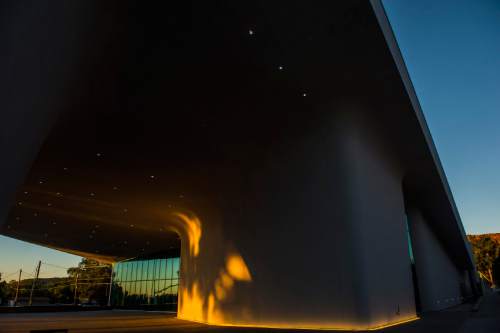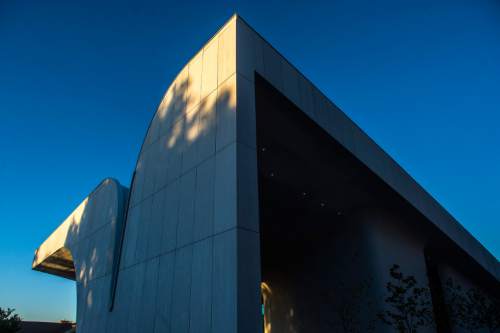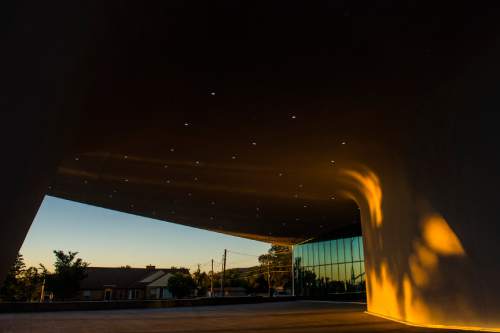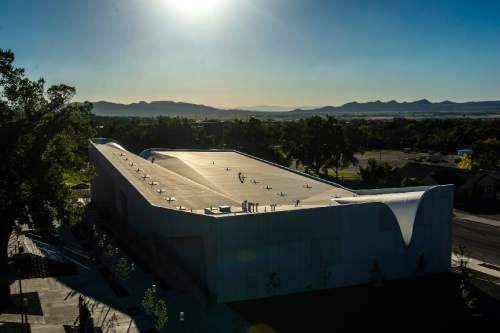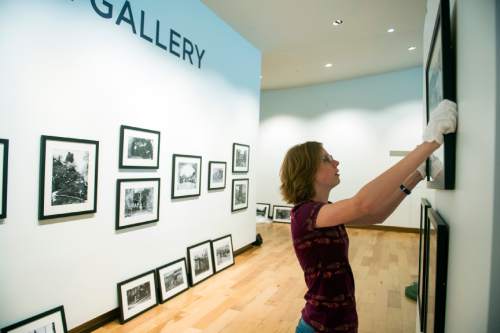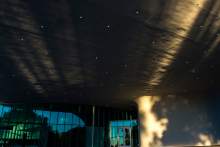This is an archived article that was published on sltrib.com in 2016, and information in the article may be outdated. It is provided only for personal research purposes and may not be reprinted.
Reese Summers borrowed a hand-carved jewelry box from his wife to describe his vision for the architectural design of the new Southern Utah Museum of Art.
"I can describe what I would like without using any language," Summers remembers telling the design team in what he describes as his "silly, theatrical manner." "I said the museum is the jewel box of our shared cultural heritage. The building should be a work of art in and of itself. And it houses the treasures that are deemed worthy of passing on to the next generation."
Summers is the only full-time staffer of the Southern Utah Museum of Art, or SUMA, which the school describes as a "model laboratory for research, programming and evaluation." SUU aims to have the first nationally accredited art museum staffed by graduate and undergraduate students, mentored by faculty and community members.
"To have what we're doing here is reasonably rare," Summers says. "But the goal is that you would leave here with your academic credentials but you would also have real-world experience."
The jewel-box metaphor underpins the dramatic architectural sculpture of the $8 million, 20,500-square-foot museum, which opens with a ribbon-cutting celebration and public tours July 7. The opening is timed with the start of the Utah Shakespeare Festival's 55th season and the debut of two new theaters: the outdoor 913-seat Engelstad Shakespeare Theatre, replacing the beloved, retired Adams Theatre across the street, and the 200-seat Eileen and Allen Anes Studio Theatre.
"Even if you never go in the museum, you can see the protective casing as a thing of beauty that also cradles and holds the original pieces of art contained within," says architect Kevin Blalock, whose Salt Lake City firm teamed with Los Angeles-based Brooks + Scarpa to design the Beverley Center for the Arts.
The museum grew out of a legacy donation by Utah landscape artist Jimmie Jones, who became noted for paintings of Zion and the Grand Canyon. At his death at age 76 in 2009, Jones donated his Rockville home, and 15 of his late paintings, as well as the copyrights, as cornerstone funding for the museum. Earlier, he had approached the university and said, "If I give you everything I have, would you be interested in building a museum?"
"That was the beginning," says Shauna Mendini, dean of SUU's college of performing and visual arts.
Jones wanted the building to be big — and to be beautiful, Mendini says. "This is the largest single building project Southern Utah University has been involved in. As far as the arts are concerned, this is really critical. This was a dream for a very long time, and it's all coming together in a major crescendo."
The one-story SUMA features a sweeping canyonlike roof, dramatically enhanced by a 5,000-square-foot canopy designed to blur the boundaries of the indoor and outdoor space. The building's exterior curtain wall of off-white fiberglass features a textured finish of vertical, reedlike impressions, designed to create subtle shadows in the mountain sunlight.
The building's design is an interpretation of southern Utah's slot canyons, anchored by the abstractions of Jones' paintings. "We wanted it to be dramatic and powerful and striking, and at the same time, it had to fit into Cedar City," Blalock says.
The iconic design is "very contemporary and very unusual" for the community, says Diane Stewart, a Utah Shakespeare Festival board member and owner of Salt Lake City's Mountain West Gallery. The museum's dramatic courtyard bears her family's name.
For those who haven't fallen as instantly in love with the building, Mendini says they need to see the view from inside out. "Wait until you experience the art in relationship to the environment," she says.
The SUMA building was designed to stand alone, but also to serve as an anchor of the 8-acre Beverley Center for the Arts, along with the Utah Shakespeare Festival's three theaters. Together, the buildings function as an arts campus within the SUU campus. "It's a full fusion of the arts in one space, and it's absolutely remarkable," says Mendini of the pairing of the regional Tony Award-winning professional theater company and an educationally focused art museum.
In addition to the Jones collection, the building features five flexible gallery spaces, defined by movable walls. Summers compares configuring the exhibit spaces to children playing with Tinker Toys, Lincoln Logs and LEGO bricks. That flexibility will allow curators to be creative with the spatial design of exhibits as well as the content. "The exhibit itself will reshape the space," Mendini says.
The transparency of the museum's teaching mission is apparent in the building's layout, which includes windowed studios that will allow visitors to watch workers preparing exhibits and working on art conservation projects.
One of those galleries was named in honor of the father of Maud Trismen Mason, an artist and former art curator at Florida's Rollins College who retired to Kanarraville and was known as Miss Maud locally. Miss Maud was so taken with the museum's education mission that she became an early donor to the project, supporting an arts administration assistantship, as well as a studio named for her father.
Summers says he drew upon his more than 30 years of experience working in academic museums and galleries to develop the program to support it. "If I were to start my career over again, this is the program I would love to have gone through," he says.
His passion for the project has even become a part of the building itself. Several months ago, he rode with the building superintendent on a crane to observe the steel beam at the top of the cantilever overhang. On the beam, he wrote with permanent marker: "For my small part in this building, I'm doing it for my great-great-grandchilden."
Summers relishes the fact that his inscription is completely hidden, like a treasure nestled inside a jewelry box. "To have my name on a building would embarrass me," he says. "But I'm very proud of writing that on a beam and telling my kids about it. No one will ever see it until they have to replace it. In my small way, this is for the future."
facebook.com/ellen.weist —
Work of art
The Southern Utah Museum of Art opens with a ribbon cutting and public ceremonies on Thursday, July 7, beginning at 10 a.m.
The building is one of the anchors of the new Beverley Center for the Arts, named for the late philanthropist Beverley Taylor Sorenson, nestled between Cedar City's Center Street and College Avenue and designed to be a campus within the Southern Utah University campus. The center was designed by Salt Lake City's Blalock & Partners and Los Angeles-based Brooks + Scarpa, and built by Big D Construction.
Ongoing exhibits
Permanent exhibit • Jimmie Jones, "The Final Paintings."
Current student work • Revolving exhibit of SUU Art and Design graduate and undergraduate student work in the Maud Trismen Mason Gallery.
June 25-July 16 • "First Peek." A juried show by regional and national artists.
June 25-Oct. 1 • Kevin Kehoe, "Western Therapy." An exhibit, courtesy of Salt Lake City's Modern West Fine Art, by a Heber Valley artist who focuses on the relationship between "landscape and light, person and place." Kehoe has drawn inspiration from Jimmie Jones' works, according to gallery owner Diane Stewart.
July 7-Aug. 27 • "Find Your Park." Featuring work from 27 Southern Utah University students marking the 100th anniversary of the National Park Service.
July 7-Sept. 1 • "The Grand Circle Tour." Black-and-white photographs from mid-20th-century train tours of national parks, courtesy of SUU Library's Special Collections.
Sept. 23-Oct. 31 • Andy Nasisse, "Shadowlands." The ceramics artist presents landscape photography and ceramics sculptures that mirror images in rock formations.
Oct. 13-Dec. 15 • Young Sil Rho. The Korean artist has created paintings from her visits to Zion National Park and donated many of her paintings to SUMA.


